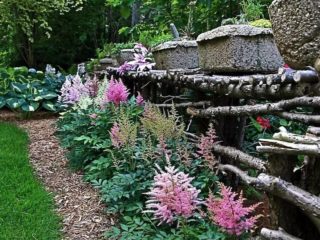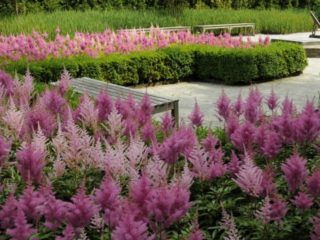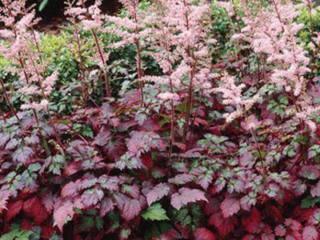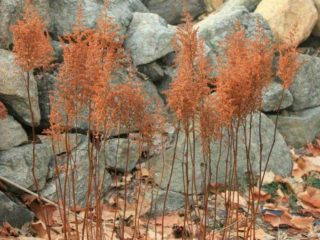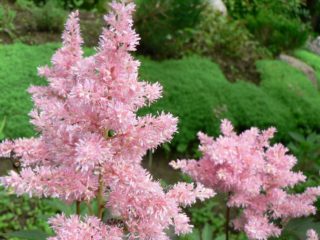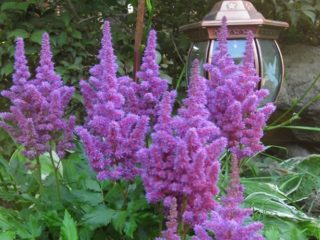Content
Astilba Weiss Gloria is a perennial ornamental plant that attracts with delicate white inflorescences, bright green foliage, and an unusual aroma. Astilba blooms from the beginning of July, does not require special care, easily tolerates frosty winters. It is appreciated by flower growers and landscape designers.
Description of astilba Ardens Weiss Gloria
Astilbe Arends Weisse Gloria is often used as the centerpiece of decorative landscape compositions. It is a perennial plant that blooms in conical panicles of small white flowers. One panicle contains several hundred inflorescences. The foliage is large, carved, richly colored.
There are about 40 varieties of astilba growing in the wild world. Another 300 have been bred by humans. Astilba Arends is a cross between Astilbe and arendsii. Wild astilbe grows in geographic regions:
- Japan;
- America;
- Kuril Islands.
Human-grown Astilba Weiss Gloria is a beautiful, abundantly flowering plant ideal for shaded areas of the garden. Landscape designers appreciate it for its elegance, subtlety of elastic shoots. The bush consists of numerous sturdy twigs.
White astilba Weiss Gloria grows in width to half a meter, reaches 75 cm in height. In spring, the foliage is light green, over time it changes its shade to a more juicy, saturated and dark one. The edges gradually turn brown. In summer, the leaves shine, creating an additional decorative effect of the bush. Flowering is plentiful, inflorescences are numerous. The culture blooms with dense, large diamond-shaped panicles. Each individual inflorescence is white with a cream shade, sometimes with a slight yellowness. The flowers are small, fragrant, very delicate.
Astilba Weiss Gloria belongs to the shade-tolerant varieties of ornamental plants. It is chosen for decoration of shady corners of the garden. A constantly lit area is not suitable - the bush becomes shallower, loses its luxury, the shoots weaken. If there are no areas of natural shade, the culture is planted and artificially shaded over it. This is especially important during the hot season. In order for the bush to grow well, conditions are necessary:
- regular soil moistening;
- control of acidity level (neutral environment is optimal).
On dry and poor soil, the specimen quickly dies.
Astilba Arendsii Weisse Gloria is a frost-resistant culture. The cold can damage young plants in the first cold season, as well as very old bushes whose rhizomes are too close to the surface. To protect the specimen from frost, the area at the roots is covered with a layer of mulch 20 cm thick. No additional covering work is required.
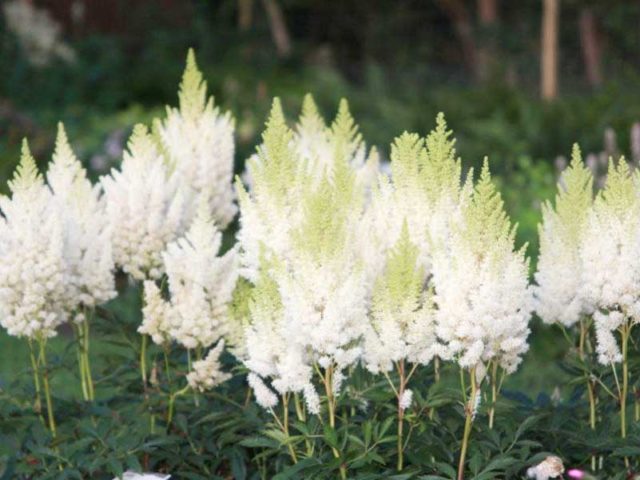
Astilba is suitable for decorating hedges, ponds, paths.
Flowering features
Astilbe Weisse blooms with panicles. Inflorescences are white, with a slight creamy shade in the first week of appearance. Paniculate inflorescences grow well and retain their beauty for a long time in a shaded area of the garden. They have a delicate, noble aroma, slightly reminiscent of bird cherry. The smell is subtle: you can smell it. Flowering duration is 2-6 weeks.
The diameter of the inflorescence is 10-12 cm. The height of the panicle reaches 25 cm. Astilba Weiss Gloria blooms from the middle of summer. Ornamental leaves of an unusual shape are valued no less than inflorescences. The splendor of flowering depends on the quality of the soil and the degree of moisture in the soil, on the abundance of shade.
Astilba leaves Weiss Gloria - with two or three feathers, jagged edges. The main color is a dark, saturated green. The degree of leaf gloss depends on the season and the characteristics of the particular plant.
In spring, the greens are very light. The brownish border of the leaves appears in summer. Possible brownish specks in internodes.
Application in design
Culture in landscaping is good both as a single element and as part of a group. Compositions formed by flowers of different varieties look very impressive. Astilba Weiss Gloria gets along well with other decorative cultures. Alpine slides are often decorated with it. A large bush can be the dominant feature of the foreground or an effective backdrop to the main composition.
Astilba Gloria Weiss is suitable for decorating ponds in the garden. She is planted:
- ponds;
- swimming pools;
- the edges of the garden paths.
Create flowering hedges. If there is an unaesthetic area on the site that needs to be hidden from prying eyes, it is the spreading astilba Gloria Weiss that will close this place.
Astilba Weiss Gloria is good as a tapeworm, that is, a solitary plant that adorns the landscape. The bush looks no worse in combination with other varieties of living decor. Often it is combined with conifers, hosts and ferns. White panicles are beautifully combined with badan, brunners. Against the background of the rich greenery of the bush, luxurious iris flowers look very impressive. The combination with bright varieties of Heucher attracts attention with a pronounced contrast.
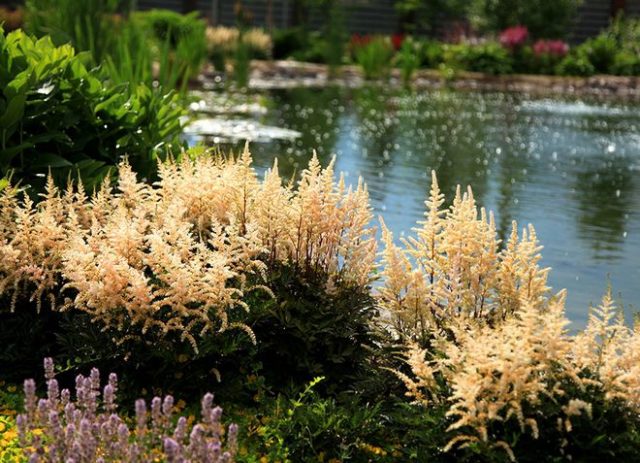
Like the inflorescences, the carved dark leaves of astilba are valuable for decoration.
Reproduction methods
The classic option is dividing the bush. It is safe because Astilba Weiss Gloria recovers quickly. Use a specimen 3-4 years old. They dig it out, cut the rhizome into pieces, making sure that at least 3 buds are preserved on each. The lower part of the rhizome is removed. After completing the division, the bush is immediately planted or instilled.
The best season for work is early spring, before flowering. If breeding is scheduled for early autumn, plant a specimen in advance so that it takes root before a cold snap.
The alternative is budding. The optimal season is spring, a period of active growth. The buds are cut off at the rhizome, the wound is sprinkled with activated carbon, and the removed part is planted in the ground, covered with a film (glass), creating a greenhouse effect. After waiting for the full formation of the plant, transplant it into open ground. Disembarkation in the country usually falls in autumn, spring.
Less commonly propagated by seeds. There are approximately 24,000 seeds per gram of fruit, but only a small amount is actually viable. Seeds are harvested in early autumn in inflorescences. Sowing falls on the end of February, March. Fertile, loose soil is required. Seeds are scattered over the surface of the ground, cover the container with a film. From time to time sprayed from a spray bottle. Seedlings are visible in 2-3 weeks. A pick is recommended when the first true leaves appear. A transplant in the main place of growth is prescribed at the beginning of summer or very much.
Landing algorithm
The growth rate of astilba Weiss Gloria is determined by the moisture content of the soil, the temperature of the environment. Between large bushes, a distance of up to half a meter is necessary, 30 cm is enough for low varieties. Before planting, the soil is dug up, removing debris and weeds, and the soil is enriched with compost, peat, and manure. 2 buckets of fertilizer are used per 1 m2. Thoroughly spill the soil.
The depth of the planting pit is 20-30 cm. 1 tsp is poured into the hole. granular fertilizer, a few tablespoons of ash. After that, the site is spilled again. When planting a bush, the plant is buried so that the growth buds are separated from the surface by 4-5 cm. After finishing the work, they compact the soil, cover with mulch, and spill it again.
The best place for planting is shaded areas of the garden, north side. Areas of high humidity are chosen, if any, they are planted near reservoirs.
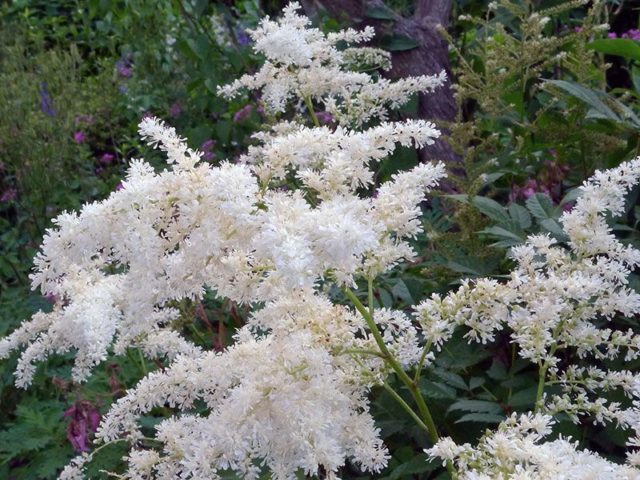
Astilba blooms with lush, large panicles of white, cream shade.
Follow-up care
Astilba Arends Weiss Gloria is undemanding. The most important thing is timely, abundant watering. Even a short drying out of the soil leads to a loss of decorative qualities: the leaves wither, the flowers become small, the specimen as a whole looks sloppy, unpresentable.
Winter frosts astilbe Weiss Gloria are not terrible, but temperature drops in spring can damage. To protect the rhizomes, cover the soil with 2 layers of spruce branches. Mulch is laid between the bushes - pine needles.
In order for Astilba Weiss Gloria to bloom beautifully and profusely, once a year a specimen is fed. Dry soil is combined with peat, compost. Complex additives are useful if the soil is wet. After flowering, combined fertilizers with phosphorus and potassium are applied.
The life of the bush is 5 years. Then astilba Weiss Gloria is transplanted. It is not necessary to completely dig out the rhizomes, it is enough to separate the upper part and disinfect the cut with charcoal.
Preparing for winter
Astilba Arends Weiss Gloria easily endures the cold. So that the rhizomes do not suffer from frost, cover the soil with mulch. Layer thickness - up to 20 cm.
In the fall, the upper part of the plant is cut to the roots. If shoots are not cut off, they must be removed in the spring, before new ones appear.
In autumn, the soil around the bush can be sprinkled with ash. This protects against diseases, provides useful substances, helps to gain strength before the new year and the next flowering season.
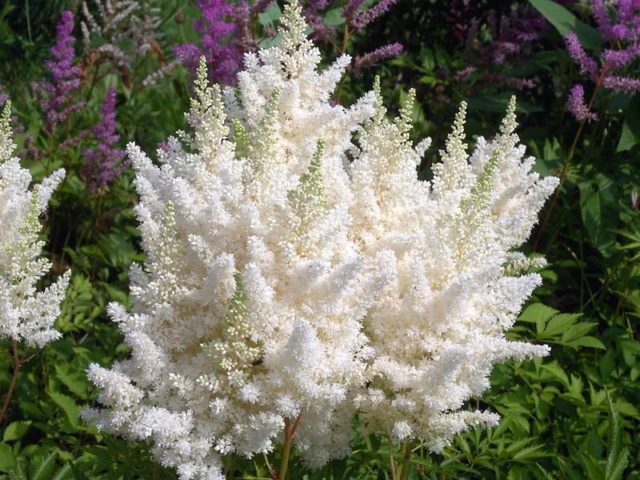
Astilba colors range from pure white to creamy and yellowish.
Diseases and pests
Astilba Weiss Gloria White is relatively resistant to pests and diseases.
The slobbering penny is dangerous to the bush. This is a medium-sized cicada (body length - 5 mm). The pest leaves eggs on the shoots, leaves of the plant. The only way to eliminate the penny is to collect it by hand. The pest feeds on the leaves of astilba Weiss Gloria, inhibiting their growth. In an infected specimen, peduncles do not develop, the leaves wrinkle, wither, and fall off.
Another pest is the strawberry nematode. It is a worm 0.5 mm long, capable of sucking juice from a leaf. You can notice the nematode in the spring, when young buds appear: the petioles are thicker than normal, the leaf blades are deformed. The pest slows down the growth of Astilba Weiss Gloria. Having identified a nematode, they dig out a bush with a large clod of earth, carry it outside the garden, and burn it.
Another dangerous worm is the root knot nematode. The length of the pest is up to 2 mm. It penetrates into the root system, inhibits the growth and development of the specimen. In the rhizomes, foci of decay appear, the leaves fall off. With a strong infection, there is no chance of a cure.
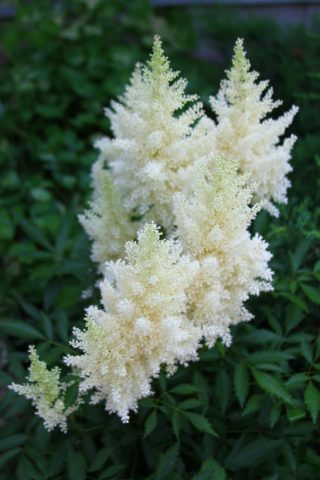
Astilba panicles attract with a delicate aroma
Conclusion
Astilba Weiss Gloria is an easy-to-cultivate, unpretentious and very beautiful plant. It takes root well in our climate, relatively rarely gets sick, does not require specific care. The culture fell in love with gardeners and gardeners, and is highly valued in landscape design.

